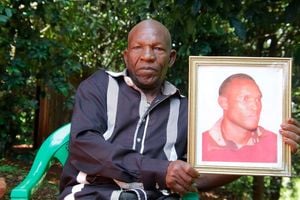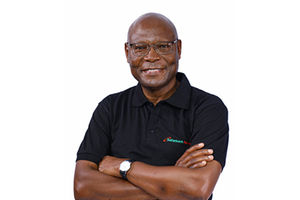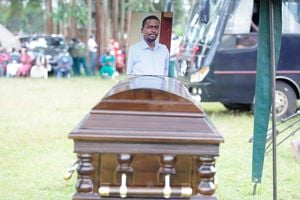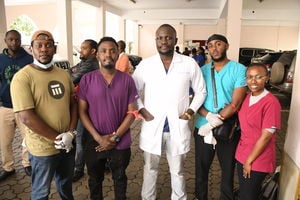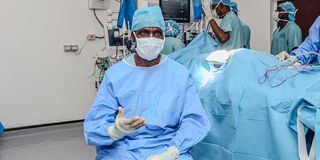
We arrive at Gertrude’s Children’s Hospital in Muthaiga, Kiambu County at 5 am on Thursday and the facility is already buzzing with activity.
We notice a woman in her late 30s seated alone outside the surgical ward lost in deep thought, looks haggard and from a distance, her lips move yet no sound comes out.
The woman who reveals that she has not slept properly for a long time introduces herself as Nancy Ambogo, with her son 15-year-old Fred Omondi.
“Sleep disappeared two years ago when my last born son Fred one day started vomiting blood endlessly. He would toss and turn in bed day and night writhing in pain and would cry out my name for help. Seeing your child in so much pain is horrible. When you visit three different hospitals back-to-back and they tell you they don’t know what’s wrong with him and cannot help, the pain kills you slowly,” she explains.
Ms Ambogo is a widow and a resident of Kakamega County but is married in Siaya.
“Today Fred Omondi goes into surgery for the next five hours for a procedure doctors tell me will determine whether he lives or dies,” she says.
The mother of four prays that no parent gets to ever experience the emotional turmoil, frustration and helplessness she has been through for the last two years.
On our way to the surgical ward to see Fred, we pass by ‘theatre 1’ where a team of 14 medics is having a ‘small’ meeting before ‘scrubbing in’ to operate on the ‘very special’ patient.
Fred is special because he was brought in three days ago from Jaramogi Oginga Odinga Teaching and Referral Hospital due to a very rare tumour.
Dr Francis Osawa, lead pediatric surgeon at Gertrude’s Children’s Hospital and a lecturer at the University of Nairobi School of Medicine discloses that for the last two years, the teenager has been battling what is known as pheochromocytoma, a hormone-secreting tumour that occurs in the adrenal glands.
The adrenal glands are small organs located in the upper region of the abdomen on top of the kidneys.
Because of the hormones secreted, symptoms include high blood pressure, sweating, rapid heartbeat and never-ending headaches.
In this case, the huge tumour is located on Fred’s right kidney.
This means that surgeons will have to carefully and accurately cut through three layers of skin namely the epidermis, dermis, and hypodermis then with precision remove it without tampering with his kidney while ensuring no infection or damage is caused to any other internal body organs.
Fred is sweating profusely in bed inside the surgical ward waiting anxiously for a high-risk invasive surgery that his entire existence depends on.
His mother is quick to hold onto his emaciated trembling hands as she urges all of us to bow down so that they can talk to God.
Dr Osawa assures that they are in very capable hands. “They include the circulating nurse, Pamela Laleyo, operating room manager Leah Asami, three anesthesiologists namely Dr Mark Gacii, Dr Susan Nabulindo and Dr Joe Mugambi, a resident from UoN, Irene Nduko who’s the scrub nurse, Nicholas Maina and a theatre assistant.
Three pediatric surgery residents namely Dr Hetal Gohil, Dr Adellah Wambui and Dr Benson Nilliefrank, Antony Mureithi and Moses Mwangi who are biomedical experts while I and Dr Peter Mwika will be operating on you,” the lead surgeon says introducing his team to the patient.
The time has finally come.
Fred’s mother opts to go and sit alone outside under a shade as tears of anxiety laced with fear and hope race down her cheeks, his son is being wheeled to the theatre.
“Fred has been through so much pain, he only joined Form One for two days early this year after painfully struggling to sit the Kenya Certificate of Primary School Education (KCPE) and passing. This is it, this is his last hope,” Nancy said.
Dr Osawa grants Nation permission to accompany Fred to the theatre for the entire procedure after official consent from the boy’s mother.
The anesthesiologists start off by knocking out Fred after nurses clean his body once again while paying close attention to where the right kidney is located from the outside part of the body.
They then cover the area properly with an airtight transparent polythene paper. They link Fred with tubes and small wires to a computerised system which keeps on beeping will monitor his vitals and then connect him to a plastic urine bag that is placed outside and attached at the back end of the surgeon’s table.
According to Dr Susan Nabulindo the pediatric anesthesiologist who attended to Fred, the high-risk and very complicated surgery meant that they had to be very careful.
“Before surgery, we discuss the patient beforehand with the rest of the team to ensure we are all on the same page. It is not a regular surgery as it requires a lot of investment in terms of the equipment we are using and the type of medication needed,” she points out.
She says the medication needed is not what they use every day in other surgeries. Lack of equipment and medication is the reason, according to Fred’s mother that his son was transferred to Gertrude’s.
“I spent Sh89,000 at Jaramogi for them to attend to my son, it was money I crowdsourced from well-wishers,” she reveals.
The lead surgeon said that Fred’s mother would have parted with between Sh1.5 million and Sh2 million for the surgery. But here is the good news. “Gertrude’s Foundation has decided to cater for the entire cost of the surgery,” the lead surgeon assures.
Dr Nabulindo notes that every member of their team is very important to get the job done.
“We have a cardiac anesthesiologist on board who specialises in heart issues apart from two pediatric anesthesiologists because our patient has a tumour that produces some of the normal hormones in the body but at a very high level and as a result the patient always ends up having very high blood pressures, it’s a rare condition in children.”
This means that during surgery, the high blood pressure can easily go up and down, which is why it is a high-risk operation. “Unlike other patients, patients like Fred require more monitoring and so we shall have to monitor his blood pressure through what we call invasive monitoring (minute by minute),” said Dr Nabulindo.
The anesthesiologist says the most important thing during a high-risk surgery is communication, how the team of experts talk to one another during the entire process.
“When the surgeons are handling a tumour that produces hormones it can actually harm the patient and so once in a while the anesthesiologists have to stop them from operating on the patient so that they stabilise him,” she discloses.
Generally during surgery, the anesthesiologists monitor various components of a patient’s wellbeing during anesthesia. When a human being is ‘awake’ but not under anaesthesia, their body is able to function normally but once medication is administered a number of functions are suppressed.
This is why during surgery, a TV-like screen that displays a mixture of green, red, blue and orange wave-like horizontal lines with numbers alongside them is placed above the front of the surgeon’s table.
Irene Nduko, the scrub nurse, is another vital member of the team.
“I am the one handling all the surgical equipment and being an assistant to the surgeons.”
She says all the equipment being used is accounted for after every five minutes.
“It is my duty to clean the equipment after every minute because once they are coated with skin they won’t work well and also to minimise infections completely,” she explains adding that she has to take stock and account.
This, she says, ensures that whatever goes in, the patient comes out.
The two surgeons Dr Osawa and Dr Mwika, after five hours of skillfully cutting into the three layers of skin, reach Fred’s right kidney and immediately locate the tumour.
The two-inch (5 cm) ball of meat that has been slowly sucking the life out of Fred is exactly where their test series of tests has predicted it was.
The two surgeons smile broadly.
Here it is! What happens next?
The anaesthetists, surgeons and pain specialists will now combine forces to take care of the patient in terms of pain management as he recuperates under their care.
When Nation.Africa visited Fred on the next day (Friday), he had woken up from his deep anaesthetic sleep.
“I can’t wait to get back to school and see my siblings and friends. I know I have missed out a lot but when I get back, I will work to make up for the lost time,” he said.
Rare kind of tumour and the endless pain
The teenager has been battling what is known as pheochromocytoma, a hormone-secreting tumour that occurs in the adrenal glands.
The adrenal glands are small organs located in the upper region of the abdomen on top of the kidneys.
Because of the hormones secreted, symptoms include high blood pressure, sweating, rapid heartbeat and never-ending headaches.

